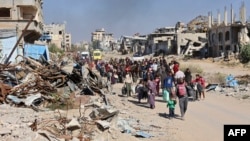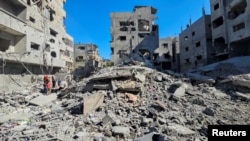A new United Nations report warns that the catastrophic humanitarian impact of the war in Gaza has set back development in the Palestinian enclave by seven decades and will imperil Palestinians for generations — and not only in Gaza.
“Projections in this new assessment confirm that amid the immediate suffering and horrific loss of life, a serious development crisis is also unfolding — one that jeopardizes the future of Palestinians for generations to come,” said United Nations Development Program, or UNDP, administrator Achim Steiner.
In a statement coinciding with Tuesday’s launch of the UNDP report, produced in coordination with the U.N.’s Economic and Social Commission for Western Asia, Steiner observed that “even if humanitarian aid is provided each year, the economy may not regain its precrisis level for a decade or more.”
The new assessment is replete with shocking statistics. It estimates that poverty in the Gaza Strip and Israeli-occupied West Bank will rise to 74.3% in 2024, up from 38.8% at the end of 2023, “affecting 4.1 million people, including 2.61 million people who are newly impoverished.”
Because of “staggering” economic losses, the gross domestic product is projected to contract by 35.1% this year, with unemployment potentially rising to 49.9%.
“Unemployment is skyrocketing, and one in two people is jobless,” said Chitose Noguchi, deputy special representative for UNDP’s assistance program for Palestinians.
“In Gaza, unemployment is reaching 80%,” Noguchi told reporters in Geneva via feed from Deir al-Balah in central Gaza. “Poverty is exponentially rising. Three in four people live in poverty.”
The Palestinian territories are "experiencing an unprecedented setback in development as measured by the Human Development Index, or HDI, indicating a loss of almost 24 years of development gains,” she said, describing the territories as the “State of Palestine.” Dozens of countries recognize a Palestinian state, but the United States and most Western European countries do not.
Underscoring this grim assessment, authors of the report say that the HDI in the Palestine territories may fall to 0.643, “a level not seen since HDI calculations began in 2004.”
Authors of the report expect Gaza’s HDI to drop to 0.408, “erasing over 20 years of progress.” They said the HDI of the West Bank is expected to decline to 0.676, “reflecting a loss of 16 years of development.”
The assessment presents three possible scenarios for early recovery. The first two consider “Restricted Early Recovery” or “No Early Recovery” at all. “Under these two scenarios, the current strict ban imposed on Palestinian workers persists as well as the withholding of ‘clearance revenues’ to the Palestinian Authority.”
“The only difference between these scenarios is the level of humanitarian aid allocated to address immediate needs,” the report said. “With no early recovery at all, the assessment assumes aid would remain unchanged from current levels,” an amount of around $280 million annually.
“Even if it flowed at the rate of $280 million every year for 10 years,” said Noguchi, “simulations in this assessment show that humanitarian aid alone cannot put the Palestinian economy on a restorative track to restore prewar levels and align with Palestinian development goals.”
She said investments allowing recovery efforts to go ahead are crucial, adding that “recovery must be enabled to eventually support reconstruction of destroyed capital and restoration of lost livelihoods.”
“Restrictions that are currently stifling the economy must be lifted,” said Noguchi, adding that this would improve the business climate, “allowing the private sector to contribute to recovery and reconstruction.”
Authors of the report agree that putting Gaza back together will be a very costly matter, given the number of casualties estimated by Gaza’s Health Ministry — nearly 43,000 killed and some 100,000 injured — and the widespread destruction of essential infrastructure and collapse of regional health care and economic systems.
Israel launched the war with a declared goal of freeing Israeli hostages and ending Hamas’ control of Gaza after the group staged a terror attack on Israel that claimed some 1,200 lives.
A report issued by the World Bank in April estimated the cost of damage to critical infrastructure in Gaza to be around $18.5 billion.
“Our assessments serve to sound the alarm over the millions of lives that are being shattered and the decades of development efforts that are being wiped out,” said Rola Dashti, executive secretary of the U.N. Economic and Social Commission for Western Asia.
“It is high time to end the suffering and bloodshed that engulfed our region,” she said. “We must unite to find a lasting solution where all peoples can live in peace, dignity, and reap the benefit of sustainable development.”








